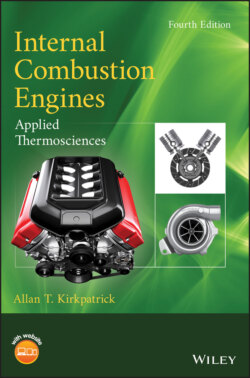Читать книгу Internal Combustion Engines - Allan T. Kirkpatrick - Страница 73
Solution
ОглавлениеThe input parameters to the MATLAB® program CIHeatRelease.m are listed in the printout below.
Compression Ignition heat release Ti = 283; inlet temperature (K) Pi = 1.00; inlet pressure (bar) MWair = 28.97; air molecular mass (kg/kmol air) rc = 15; compression ratio S = 0.165; stroke (m) B = 0.165; bore (m) N = 1500; engine speed (rpm) PHI = 0.7; equivalence ratio F = 0.05; residual fraction FS = 0.06993; stoichiometric fuel‐‐air ratio ao = 45730; fuel available energy (kJ/kg) CN = 40; Cetane number THETAI = -12; start of injection (deg) THETAD = 15; injection duration (deg) ...
The and parameters for this example are as follows: The cylinder volume at bdc is
The mass of air in the cylinder at bdc is
The molar mass of air in the cylinder at bdc is
The injected fuel total energy is
For an ignition delay of 4.14,
The energy release during the premixed phase is
and the energy release during the diffusion burn phase is
The diffusion energy release per kmol of air (MJ/) is therefore
and the diffusion burn duration is
The energy release profile produced by CIHeatRelease.m for the above engine parameters is plotted in Figure 2.24. The maximum energy release rate is during the premixed burn with a rate of about 750 J/deg at −5. Note that most of the energy release for the combustion parameters of this example occurs during the diffusion burn phase, which lasts about 74.
Comment: One limitation of the dual Wiebe function approach for compression ignition is that it is difficult to represent multiple pilot and post fuel injections. For each additional injection, an additional Wiebe function, with specific experimentally determined parameters, is required.
Diesel energy release profile for Example 2.7.
